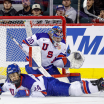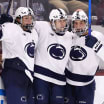The Scouting Meeting is a feature that will run throughout the 2024-25 season written by Scott Harris, a former director of scouting operations for the Colorado Avalanche and New Jersey Devils.
In his debut, Harris writes about how NHL teams utilize NHL Central Scouting's midterm rankings, which were released Tuesday.
NHL Central Scouting is an indispensable pillar of the NHL Draft process. Under the guidance of Central Scouting director Dan Marr, associate director of scouting David Gregory, director of European Scouting Services J-P Vuorinen, senior manager Steve Rachkowski and the rest of the dedicated staff, Central Scouting works tirelessly for the NHL and its 32 clubs. Their efforts often go unnoticed, but they deserve full recognition.
Without NHL Central Scouting, the draft would not meet its current high standards. Their role goes beyond scouting and providing insights on players. They support NHL teams, leagues, draft prospects and countless others involved in the draft process. They handle much of the behind-the-scenes work that scouts and executives rely on.
With 17 years of NHL scouting and directorial experience, I can confidently say Central Scouting's work is critical. They act as the "first assist," streamlining and enhancing the scouting process for everyone involved. The organizations I have worked for and myself have benefited repeatedly from Central Scouting.
Central has pulled us scouts through different spots, whether it was being adequately directed to games in Europe while driving foreign roads, informing us when players are called up or sent down at the last minute amongst their respective clubs, or receiving updated player information in the final hours before hitting the draft floor.
The release of Central Scouting's midterm rankings is a significant milestone each season. These rankings become a focal point for discussions during amateur scouting midterm meetings across NHL organizations. During my career, I directed staff arriving at these meetings to be prepared to review and compare internal regional, positional and overall lists. We would then include Central's rankings to provide an additional perspective.
When reviewing Central Scouting's midterm lists, the first task often is to identify potential consensus on the top 20-25 players for the upcoming draft in June. The next step involves comparing these rankings to internal lists. This exercise sharpens evaluations and challenges scouts, directors and analytics teams to foster a more comprehensive understanding of the draft class.
It's important to remember that Central's rankings represent a wealth of scouting expertise, but they are not meant to define any one team's identity. For example, Central may rank a player in their top 20 who, while talented, may not fit a specific team's identity or draft strategy.
As I write this and reflect, it was a common theme to have one or two players on Central's midterm lists stand out that was either, to some, too high or too low or simply not an "identity" player. With the emphasis of midterm meetings being more about player recognition rather than a final stamp of approval, Central's rankings still would bring out the passion and conviction in scouts and make for animated conversation. This dynamic encouraged healthy discussions and ensured that regional and cross-over scouting perspectives were well-represented. This was always welcomed by management.
The general managers I've had the pleasure of working with and hold in high regard each brought their unique styles to the draft process, shaped by their individual experiences. While they each approached Central's rankings in various ways, all recognized the value of these lists in crafting a comprehensive draft strategy. Their insights and enthusiasm shone through during our midterm meetings.
Central Scouting's midterm rankings play a crucial role in second-half planning. In collaboration with internal lists, the top half of Central's rankings guides crossover scouts, head scouts and management schedules, helping them focus on priority players. The bottom half ensures thorough coverage and identifies areas where additional information is needed.
Unforeseen circumstances such as injuries, weather, geography and limited regional coverage can complicate evaluations. For instance, assessing a backup goalie or an under-the-radar player in a nontraditional market can be challenging. Central Scouting helps bridge these gaps by providing essential information and insights to supplement team efforts.
Every amateur scout must master their domain. By leveraging Central Scouting's lists and reports alongside other resources, scouts can ensure comprehensive coverage and accurate evaluations. In today's NHL salary cap era, hitting on first- and second-round picks is crucial, but so is uncovering gems in later rounds. Amateur scouts play a pivotal role in achieving this balance.
Having participated in the NHL draft firsthand, I have developed immense respect for the individuals who contribute to this process. I have also come to deeply appreciate the integrity of the list-building process, which serves as the foundation for draft success.
NHL Central Scouting, their lists, rankings and provided information are vital to that foundation.
















